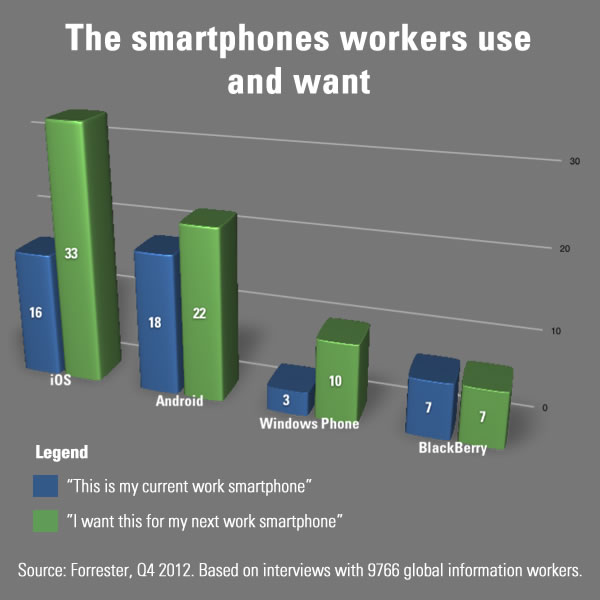Free Ebook: The Executive’s Guide to BYOD and the Consumerization of IT
 If people you know are trying to work their way through the hedge maze of letting employees bring their own devices to work, give them the free ebook The Executive’s Guide to BYOD and the Consumerization of IT. It’s a collection of what TechRepublic and ZDNet consider to be some of their best recent articles on the topics of BYOD and its older, more generic cousin, the consumerization of IT.
If people you know are trying to work their way through the hedge maze of letting employees bring their own devices to work, give them the free ebook The Executive’s Guide to BYOD and the Consumerization of IT. It’s a collection of what TechRepublic and ZDNet consider to be some of their best recent articles on the topics of BYOD and its older, more generic cousin, the consumerization of IT.
Here’s a list of the articles contained within the book:
- Consumerization of IT, BYOD, and mobile device management
- Survey: 62% of companies to allow BYOD by year’s end
- Can BYOD make the IT department a hero again?
- BYOD in the midst of war: How IT consumerization is keeping the US military in touch with home
- Five security risks of moving data in the BYOD era
- Surface RT versus iPad: BYOD tablet showdown
- BYOD is on the rise in Asia, but challenges remain
- 10 reasons BYOD may be a bad fit for your organization
- Case study: How Dimension Data is reaping huge benefits via BYOD
- 10 questions on BYOD in the enterprise, with Peter Price, CEO of Webalo
Once again, the book is free. If you’re a member of TechRepublic, you can download it immediately; if you’re not, you’ll have to register first (it’s free).
More Tidbits from Forrester’s Mobile Workforce Adoption Trends Report

In our previous post, we featured Forrester Research’s Mobile Workforce Adoption Trends report — yours for the low, low, low price of US$2495 — and showed some data on what smartphones and tablets were used and wanted by nearly 10,000 information workers in 17 countries surveyed.
Here are a few more tidbits from the report that you might find useful or interesting. Alas, we don’t have the “two and a half large” to spare for the full report, so we’re working with material culled from the report from sites with larger budgets.
- Forrester could tighten up their classification of “information worker”. Their definition is “people who use a computer to do their jobs an hour or more a day.” That could apply to just about anybody with a job in North America these days.
- Where do people use smartphones? Apparently, a lot of the “information workers” (or should I just say “everybody”?) surveyed use them everywhere, if you take the data to be accurate: they’re using them at home, on the way to and from work, and at work…
- 64% said “at my work desk”,
- 69% said “at home”, and
- 64% said “while commuting”.
- Over one-third are willing to chip in for better gear. 36% of the survey respondents said that they’d be up for ponying their own money to help the company cover the cost of a computer of their choice. Forrester interprets this as “I’d like to throw in my own money on top of the company so that I get a Mac”, and we think they’re right.
- Dropbox is big. 70% of the respondents say they use it; half of them say they use it only for work.
Mobile Workers are “The New Norm”

IDC Canada’s Canadian Mobile Worker 2012–2016 Forecast — priced at CA$4,500, which makes Forrester’s Mobile Workforce Adoption Trends report look like a bargain — suggests that mobile workers are the new norm. They define a mobile worker as someone who does some of their work each week outside the office. 68.9% of employed Canadians — 12.1 million in total — fell into this category in 2012. They predict that by 2016, this fraction will climb to 73%, or 13.3 million working Canucks.
The Globe and Mail interviewed the author of IDC Canada’s report, Krista Napier, a senior analyst at IDC and also a board member at Toronto’s Mobile Experience Innovation Centre. Some quick hits from the interview:
- Mobile workers are more prevalent in smaller companies, where they work away from the office at least three days a week. We’ve seen this ourselves; it’s not all that common in Toronto’s startup/small tech company scene.
- BYOD in Canada:
- In 2012, 48% of IDC’s survey respondents said that they were already using personal devices at their main workplace.
- In the same year, about 30% of Canadian companies had a BYOD policy in place, with another 26% planning to have one in place by the end of the year. That still leaves 44% without any BYOD plans. These guys might want to have a word with us about our services.
- One device to rule them all? Not in the near future, anyway, say Napier. People these days own more, not fewer, devices, and tablets and smartphones are supplementing rather than replacing laptops outright. Napier often leaves her laptop at the office, preferring her tablet and large-factor smartphone (from the description, it sounds like a Samsung Galaxy Note) when she’s “out and about”.
- Mobile work has its downsides: Most importantly, less face-time can lead to less collaboration and missed opportunities. There’s a reason why the expression for doing something half-heartedly is “phoning it in”.
This article also appears in Mobilize! The CTS Mobile Tech Blog.















 It’s yet another Microsoft technology that entered with much fanfare, followed by much fandom, then left to die like a forgotten dog in a car on a hot August day. It’s another sign of the rot deep within The Empire, and some very big problems with which their (mis)management has to contend. While I have much to say on that topic, I’ll leave the final word to Promit Roy, who sums up my opinion on whether or not you should bet on the Microsoft platform:
It’s yet another Microsoft technology that entered with much fanfare, followed by much fandom, then left to die like a forgotten dog in a car on a hot August day. It’s another sign of the rot deep within The Empire, and some very big problems with which their (mis)management has to contend. While I have much to say on that topic, I’ll leave the final word to Promit Roy, who sums up my opinion on whether or not you should bet on the Microsoft platform: